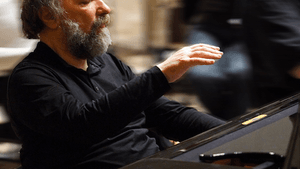Stay in the Loop
BSR publishes on a weekly schedule, with an email newsletter every Wednesday and Thursday morning. There’s no paywall, and subscribing is always free.
After the 'Dutchman'
Philadelphia Orchestra's Yannick Nézet-Séguin conducts Mozart and Bernstein (first review)

Energized by his first performance with the Metropolitan Opera in a compressed version of Wagner’s The Flying Dutchman, Yannick Nézet-Séguin returned to the Philadelphia Orchestra to conduct a program of Bernstein, Mozart, and Schumann. Something of the Met must have rubbed off on him; he conducted with a newly operatic sweep of gesture, particularly in the Schumann. Not that I begrudge him, bestriding the podium occupied by Stokowski and Ormandy with one leg and by James Levine with the other. At the moment, he’s king of the hill. How well he keeps his balance remains to be seen.
Lamentations across the Atlantic
Leonard Bernstein’s First Symphony opened the program. It’s known more popularly as the Jeremiah Symphony, because the last of its three movements sets texts from the Book of Lamentations. This movement was composed first as a freestanding work for soprano and orchestra. Bernstein reworked it for the deeper tones of a mezzo-soprano -- the part sung here by Sasha Cooke -- when he put the symphony together, and gave biblical-sounding titles, “Prophecy” and “Profanation,” to the two preceding instrumental movements. These latter movements have a lot of Copland and Harris in them; had Bernstein simply added a third movement without text or title, he might have had a debut symphony in the American vein without overt religious connotations.
On the other hand, religious questions always preoccupied Bernstein. In 1942, when the symphony came together, it would have been difficult for a Jewish-American composer to ignore the lamentations rising from the ghettos and death camps of Nazi-occupied Europe. Bernstein didn’t respond to it directly, as Bohuslav Martinů did in his musical memorial to the Czech victims of Lidice or as Schoenberg did after the war in his A Survivor from the Warsaw Ghetto, but it is hard not to imagine it deeply on his mind, and the symphony today is inseparable from the Holocaust. Certainly, to hear the sung text Wherefore dost Thou forget us forever / And forsake us so long time? / Turn Thou us unto Thee, O Lord, is a shattering moment for anyone sensitive to the context. Cooke, a stately presence, sang with feeling and authority, and Nézet-Séguin adroitly projected the score’s shifting and somewhat eclectic moods.
Restraint and agitation
Mozart’s Piano Concerto No. 24 (K. 491) is, with the D Minor Concerto K. 466, one of only two among his 27 solo piano concertos in a minor key. K. 491’s key of C minor is established at once in the weighty introduction, and the piano’s delayed entrance works like a gentle and restraining hand placed on its agitation. Veteran soloist Radu Lupu struck exactly the right note with this, and maintained a tone of intimate conversation with the orchestra throughout, although the first-movement cadenza (Lupu’s own) seemed a very personal meditation on the work’s dark coloration. The orchestra’s winds were particularly lovely in the accompaniment, and the rapport between soloist and conductor was evident. When they came back onstage together for a second bow, the two men were in earnest conversation, as if still continuing the performance.

Robert Schumann’s Symphony No. 2 (actually the third of the four he composed) concluded the program. After the slow introduction to its opening Allegro, with its somewhat misty atmosphere and chromatic wanderings, the rest of the score moves briskly, framing a third-movement Adagio espressivo that is, for me, the summit of Schumann’s orchestral writing. The work as a whole is, arguably, the finest symphony composed in the nearly half century between Berlioz’s Symphonie Fantastique and Brahms’s First Symphony, and I think Brahms must have had it in mind as a standard his own symphony had to meet.
Nézet-Séguin threw himself into the score with gusto, producing a vibrant, dynamic reading that brought out the muscularity of its outer movements and, by contrast, the pained yet exalted lyricism of the Adagio. The orchestra responded with one of its finest performances this season. Personal tragedy lay not far around the corner for Schumann, and tragedy in one form or another touched all three works on the program. It ended, though, with a great and exhilarating burst of energy—a triumph not easily won, but a triumph nevertheless.
To read Dan Rottenberg's review, click here.
What, When, Where
Yannick conducts Mozart and Bernstein. Conducted by Yannick Nézet-Séguin; Radu Lupu, piano. The Philadelphia Orchestra. Leonard Bernstein, Symphony No. 1 (“Jeremiah”); Wolfgang Amadeus Mozart, Piano Concerto No. 24 in C Minor (K. 491); Robert Schumann, Symphony No. 2 in C Major, Op. 61. May 3-6, 2017, at the Kimmel Center's Verizon Hall, 300 S. Broad Street. (215) 893-1999 or philorch.org.
Sign up for our newsletter
All of the week's new articles, all in one place. Sign up for the free weekly BSR newsletters, and don't miss a conversation.
 Robert Zaller
Robert Zaller